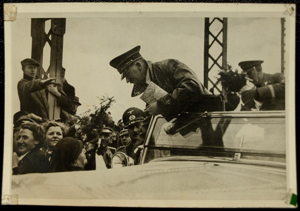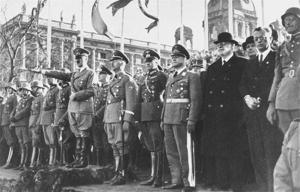On March 12, 1938, Adolf Hitler orchestrated the annexation of Austria into Nazi Germany, an event known as the Anschluss, which translates to "union" or "joining" in German. This invasion faced no significant military opposition from Austrian forces or meaningful intervention from foreign powers, marking a pivotal moment in Hitler's expansionist agenda to create a "Greater Germany" encompassing all German-speaking peoples125.
The idea of uniting Austria with Germany was not new; it had been discussed since 1919, particularly among Austrian Social Democrats, though Hitler's rise to power in 1933 made the prospect less appealing to many5. Hitler, born in Austria, had long expressed his desire for this union, as evident in his writings in Mein Kampf and strategic plans like the Hossbach Memorandum, which outlined the annexation of Austria as a step toward gaining Lebensraum (living space)4. Austria, however, sought to maintain its independence under Chancellor Kurt von Schuschnigg, who faced increasing pressure from Nazi Germany and internal pro-Nazi sentiment1.
In the years leading up to 1938, Austria's position weakened. The 1936 German-Austrian Agreement forced Austria to align its foreign policy with Germany's and allowed Nazis to hold official positions, undermining Austrian autonomy6. Additionally, Italy, once a protector of Austrian independence, aligned with Germany through the Rome-Berlin Axis, leaving Austria vulnerable26. Schuschnigg's attempts to cooperate with Hitler failed to deter German aggression, as Nazi influence grew within Austria, including key figures like Arthur Seyss-Inquart, who became Interior Minister4.
In February 1938, Hitler summoned Schuschnigg to Berchtesgaden, where he threatened invasion unless Austria made concessions, including greater Nazi participation in government. Schuschnigg, under duress, agreed to these terms but later sought to resist by announcing a plebiscite on Austrian independence scheduled for March 13, 1938. This referendum aimed to demonstrate public support for independence and potentially undermine Hitler's justification for intervention157.
Hitler, furious at the prospect of a vote that could reject unification, demanded the plebiscite's cancellation and Schuschnigg's resignation. On March 11, facing threats of invasion and lacking support from Britain, France, or Italy, Schuschnigg capitulated. He resigned that evening, instructing Austrian forces not to resist German troops, and Seyss-Inquart, a Nazi sympathizer, assumed the chancellorship. Seyss-Inquart officially "invited" German forces to restore order, a move orchestrated by Berlin156.
On March 12, 1938, German troops crossed into Austria unopposed, meeting no resistance from the Austrian military, which was vastly outmatched and ordered to stand down. Hitler himself entered Austria, receiving enthusiastic welcomes from many Austrians, particularly in his hometown and Vienna, though not all supported the Nazi regime. The lack of resistance was due to a combination of military disparity, internal divisions, and a significant portion of the population favoring unification after years of economic hardship and political instability26.
The annexation was formalized on March 13, 1938, when Austria was absorbed into the Third Reich. The Austrian government was dissolved, and the name "Österreich" was banned from public use. A month later, on April 10, a rigged referendum produced a 99.7% approval rate for the Anschluss, cementing Nazi control. The Nazis quickly imposed their ideology, imprisoning opponents and exploiting Austrian resources, including manpower, raw materials, and financial reserves256.
The Anschluss occurred without significant international pushback. France was in political disarray, with its government having resigned just days before the invasion, while Britain adopted a policy of appeasement, unwilling to intervene. Italy, under Mussolini, had shifted allegiance to Germany, abandoning its earlier stance of protecting Austria. No foreign power took decisive action to oppose Hitler's move, allowing the annexation to proceed unchallenged26.
Conclusion
Hitler's invasion of Austria in March 1938 succeeded without opposition due to a combination of Austrian military weakness, internal support for unification among some Austrians, Schuschnigg's inability to resist German pressure, and the absence of international intervention. The Anschluss marked a significant step in Nazi territorial expansion, setting the stage for further aggressions in Europe as Hitler's vision of a "Greater Germany" took shape125.
Citations:
- https://encyclopedia.ushmm.org/content/en/article/nazi-territorial-aggression-the-anschluss
- https://www.worldhistory.org/Anschluss_of_Austria/
- https://www.youtube.com/watch?v=zpO8wHHEDa0
- https://en.wikipedia.org/wiki/Austria_within_Nazi_Germany
- https://www.britannica.com/event/Anschluss
- https://www.bbc.co.uk/bitesize/guides/z92hw6f/revision/3
- https://www.deseret.com/2015/3/11/20560461/this-week-in-history-nazi-germany-annexes-austria/
- https://www.historyskills.com/classroom/year-10/anschluss/
- https://www.junobeach.org/canada-in-wwii/articles/peace-for-our-time/
- https://www.reddit.com/r/ww2/comments/1fvddcf/why_didnt_hitler_just_stop_after_annexing_austria/
Answer from Perplexity: pplx.ai/share




No comments:
Post a Comment